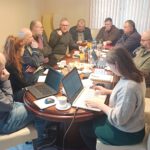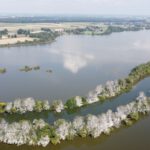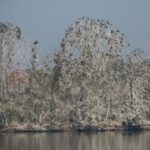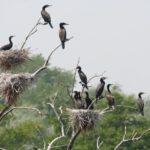Management of the population of the cormorant Phalacrocorax carbo in the Upper Vistula Valley PLB240001 Natura 2000 area in the context of increased pressure of these birds on fisheries management was the subject of a meeting on February 7, 2023, at the Upper Silesian Water Supply Company S.A. at the Goczałkowice Reservoir dam. The meeting was held as part of a reduced format of the Steering Committee of the LIFE.VISTULA.PL project.
The cormorant is a large bird with black plumage. Its colonies number up to several thousand nests. It is a very efficient and unique predator that feeds on fish. It usually hunts in flocks, and this agility in underwater hunting is allowed by its soaking feathers. As a result, the birds are hardly subject to the force of buoyancy and can satisfy their hunger very quickly. For the rest of the day, the birds rest and dry off, sitting with their wings characteristically spread.
Cormorant population growth in the region
There are currently 2 cormorant colonies in the Silesian province: on Dzierżno Duże Reservoir near Gliwice and on Goczałkowicki Reservoir in the Vistula estuary, where the birds build nests in trees. The first breeding on Goczałkowicki Reservoir was found in 1986, and within 4 years the colony had grown to 47 nests.
Over the years, the birds have increased their numbers, causing more and more damage to farm ponds. Based on an agreement between fishermen and ornithologists, in 1994 the Provincial Nature Conservator set a limit of 50 nests, above which nest reduction was carried out, usually with water cannons. At the beginning of the 21st century, nest removal was abandoned, with the result that the number of nests continued to gradually increase each year. Currently, more than 550 pairs of cormorant nest in the Vistula estuary.
People-Fish-Bird Compromise
The experience of the LIFE.VISTULA.PL project shows that the key to preserving bird habitat in the Upper Vistula Valley is to maintain and carry out extensive fishing. The farm ponds are relatively shallow and contain an accumulation of fish that is unprecedented in natural reservoirs. In addition, the ponds form a diverse mosaic and have many convenient refuges like islands and rushes. The abandonment of fisheries management, the conversion of the ponds into fishing grounds or their drainage will cause irreversible changes in the habitats of birds, which are very strongly associated with the ponds.
The motto of the LIFE.VISTULA.PL project is the recognition of interests along the People-Fish-Bird line. Due to the increasing voices of fishermen about increased cormorant pressure, the LIFE project team organized a working meeting of the Steering Committee to discuss the possibility of finding solutions to this problem. The meeting was attended by representatives of fish farms, the Upper Silesian Water Company and ornithologists.
As a result of a lively and very substantive discussion, it was concluded that the cormorant is an integral part of the landscape of fishing ponds and this situation will not change any more. Moreover, the population of this species is not threatened in any way in Europe and Poland, and taking preventive measures will not cause a long-term reduction in the population of the entire Upper Vistula Valley.
Birds arriving most of the year are very often migratory individuals. Due to the proximity of the ponds to the cormorant’s breeding colony, the birds are causing increasing losses to the fishing industry, which is of great importance for their continued operation.
Preventive measures against the harmful effects of the cormorant on fisheries management
A preventive measure in addition to the existing permits for scaring and shooting is the use of ropes and lines on small ponds to prevent cormorants from diving and hunting. Another suggestion is to install large baskets of rods in the fish feeding area, which would act as a refuge for fish, when a flock of cormorants arrives. These measures, however, will not completely eradicate fish damage and involve additional costs for pond managers.
One of the solutions is also to return to the measures used more than 20 years ago, i.e. annual reduction of cormorant nests in the estuary of the Vistula River to Goczałkowice Reservoir. According to ornithologists, such an action is effective if repeated cyclically, but it entails the risk of dispersing the breeding colony and would have to be carried out during the nest-building and egg-laying period. Ornithologists stressed that knocking down nests will not eliminate the problem of cormorant predation on the ponds, but will reduce the pressure of birds during the breeding season, when the birds feed most intensively. Taking such measures must be associated with simultaneous monitoring of the cormorant population in the area, in order to prevent the establishment of new breeding colonies.
The presented solutions have been accepted by pond managers and, although they will not completely eliminate their problems, they can, at least in part, reduce breeding losses and reduce the financial outlay associated with organizing bird strikes and shooting, which is important from the point of view of both other birds and the pond activity itself, which determines the maintenance of habitat for the valuable avifauna of the area.
Cormorant population management strategy
According to the LIFE.VISTULA.PL project team, limiting the number of cormorant nests on Goczałkowicki Reservoir may reduce the number of birds visiting ponds 10 km away from the breeding colony and reduce the frequency of direct activities on the ponds related to frightening and shooting, where birds that are objects of protection in the Upper Vistula Valley PLB240001 Natura 2000 area nest and feed.
The organized meeting partially fulfills the provisions of the “Strategy for the Management of the Cormorant Population in Poland” (Bzoma Sz., 2011, Warsaw, SGGW), indicating that the best chances for success in managing the cormorant population are actions at the local level, supported by an in-depth knowledge of the problem at this scale. It is hoped that the meeting will initiate a process of dialogue to create a regional cormorant population management plan for the part of southern Poland where the greatest accumulation of ponds is located.
- Autor: A. Siudy
- Autor: A. Siudy
- Autor: A. Siudy







